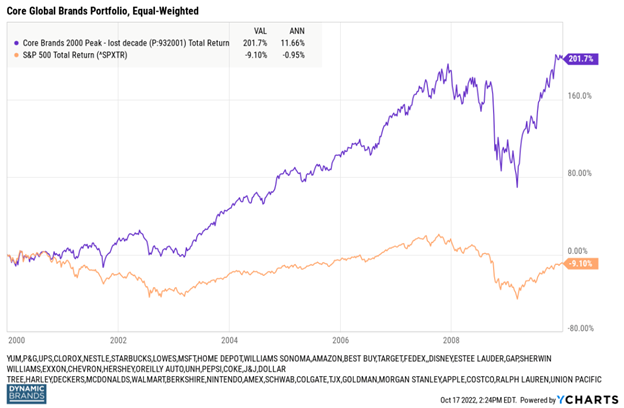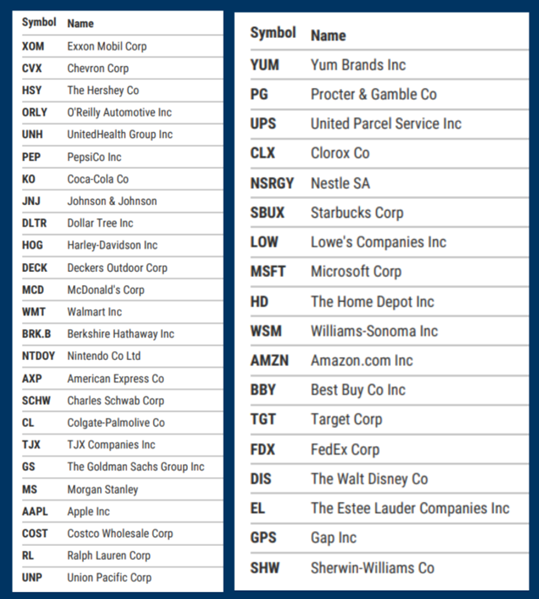Key Points
- The calls for another “lost decade” in stocks are getting louder.
- A historical look-back from the last “lost decade”, 2000-2010, shows brands mattered.
- A brand’s relevancy is vital to a company’s success. Brand relevancy changes over time.
“In good times, brands matter. In difficult times, brands really matter”
Predicting the Future is Difficult
Absolutely no one knows what will happen in the future. When you come across a person or firm that says they can predict the future, ask yourself why they aren’t sitting on a 100-foot yacht in St. Barts versus talking to the media or you about their knowledge of the future. The future is un-knowable because variable always change. Even the most well-thought-out macro view that connects the dots from one factor to another to arrive at an end-projection requires every dot to jive with the others. One breakdown in the macro dot-plot changes every other prediction making the entire prediction less likely. So why try to predict the future at all? Attention is the answer.
The world likes to hear from “smart forecasters” in times of high uncertainty. Not having any ideas about the future is a control-freak’s worst nightmare so these “experts” try to gain attention and to make money catering to your fears.
Here’s a key truth: success in the stock market is more about keeping your emotions in check than actually picking the right stocks. Great companies just win over time; there’s ample evidence of this, along with it being common sense. When investors finally can’t take the volatility and drawdowns anymore, they tend to make the absolute wrong decision at the wrong time. I’ve seen this movie play out over and over in my 30 years of investing. Just remember, buying great companies when they go on big sales is what one is supposed to be doing, not panic selling. Here’s a recent blog talking about that where I show real world examples of the gains that could have been generated if ones emotions were in check: https://catalyst-insights.com/analysis-cost-averaging-adds-significant-value/
As you are well aware, there’s plenty of uncertainty and lots of forecasting going on today. Some very smart, very successful investors have recently been predicting a potential “lost decade” in stocks going forward, Jeremy Grantham (GMO) and Stan Druckenmiller to name a few. We will not comment on the future because it’s un-knowable and therefore a waste of time to try forecasting it. What we do know: human beings earn money, save money, and spend money. Our brand loyalty or brand loathing tends to drive how and where we spend our money. The same is true at the corporate level, it’s less about the emotional connection though, and more about corporate innovation & finding productivity gains. That’s why our team created the Brands 200 Index and why we run an actively managed equity strategy based on B2C and B2B consumption. In good times and bad, consumption is happening. It changes in size and scope according to different parts of the business cycle but the companies that are driving innovation and delighting customers always win in the end.
In great economic environments even average companies perform well, but in more challenging times, arguably like today and potentially in the next few years, only the best companies even have an opportunity to thrive. We have confidence that the most relevant and admired brands serving consumers and businesses will do what they have always done: survive and thrive.
History as a Guide: 2000-2010
As Jim Cramer likes to say, “there’s always a bull market somewhere.” With that thesis in mind, let’s look at the last “lost decade” in stocks, which was 12/31/99 to 12/31/09. Here are some facts:
Lost decades tend to happen when the prior decade was abnormally positive and likely unsustainable.
The 10-year period from 12/31/89 to 12/31/99 saw the S&P 500 Index annualize at about +18.1% versus the normal, long-term average of +9-11%. Based on that statistic alone, one might expect the next decade to be something closer to normal or less than normal. As it turned out, the 10-year period from 12/31/99 to 12/31/09 saw the S&P 500 Index annualize at about -0.95%. (Source: Ycharts.com)
The 2000’s was not a great decade for the market overall. In keeping with this wide lens return thesis, the secular bull market that began March 9, 2009 until the recent highs on November 20, 2021 was also much better than average at an annualized +18.8% return for the S&P 500. The growth stocks from the Nasdaq Index performed even better. Based simply on this historical performance look-back, one could assume the next 10 years might be lower than what we are used to. In fact, as policy rates are normalizing, we should indeed expect more volatility and potentially lower returns than we are used to, at least while the normalization process is happening. In the end though, a world without zero interest rate policy and free money is a very positive development for markets and stocks.
Let’s go back to the 2000-2010 lost decade period and show how a hindsight-focused top global brands basket performed versus the market. It was a tough early part of the decade for tech brands and many other consumer stocks, but overall, an iconic brands basket performed admirably in a tough decade. This all occurred while brands like Apple, Amazon, Microsoft, Disney, American Express, Home Depot, Este Lauder, Coke, and Schwab were down a minimum of 35% of that period. Already I sense the current period is rhyming with yesteryear. As you can see from the Ycharts image below, the 43-stock portfolio, equally-weighted annualized around the long-term average for the lost decade as the overall market struggled. The best companies tend to do much better than peers in the worst of times. They have the brand awareness, the balance sheet, the free-cash flow to invest through the cycle, and they often have the best operating metrics. And all this when we had the Internet bubble bursting, a recession, the 9/11 terrorist attacks, and then the great financial crisis and housing bust of 2008/2007. It’s pretty impressive that a group of companies, let’s call them top brands, somehow found a way to perform over a wild decade with two very bad recessions. Here’s the actual performance of the brands basket and the S&P 500 during the lost decade.

Brand Relevancy Matters Today As Much Or More Than It Did In 2000
As I write this week’s commentary, some of the most admired, most profitable companies (brands) have fallen 30-60% in less than one year. That is a very rare occurrence. You can thank your politicians and the Federal Reserve for this ugly year of returns. Multiples have come back to earth and estimates have been reduced with likely a bit more reductions to come as the effects of high inflation work their way through corporate earnings. If you read last week’s blog, you saw the chart of the 1973/1974 bear market with similar issues as we have today. The market ultimately bottomed as earnings were peaking. That’s counter-intuitive for sure and there’s no way to know if the same will occur this time around but the message from that blog was: markets don’t discount a recession twice. The poor market we have today is in the process of discounting a lot of bad news and stocks will likely bottom well in advance of your fear of these news items. Here’s the link to last week’s blog: https://catalyst-insights.com/where-will-stocks-bottom/
The discounts on great businesses we have today makes investing in the most admired brands a lay-up for investors with a little time. Aside from that observation, let’s get back to a period of difficulty like the 2000’s decade. When looking at the performance chart above, clearly something worked in the last lost decade.
Here’s a few observations from the chart and the holdings in the brands hypothetical portfolio:
- The brand leaders of this period seemed well positioned from a business perspective.
- The highest quality companies always invest through difficult times because they can.
- Investing for market share when peers are re-trenching tends to drive future gains.
- Being balanced between offense and defensive business models seemed to work well.
- Bubble stocks tended to lag when the bubble popped and valuations mattered again.
Here’s a look at the hypothetical “most relevant brands” basket that performed so well:

Let’s call that the “sleep well at night” portfolio!
Disclosure:
This information was produced by Accuvest and the opinions expressed are those of the author as of the date of writing and are subject to change. Any research is based on the author’s proprietary research and analysis of global markets and investing. The information and/or analysis presented have been compiled or arrived at from sources believed to be reliable, however the author does not make any representation as their accuracy or completeness and does not accept liability for any loss arising from the use hereof. Some internally generated information may be considered theoretical in nature and is subject to inherent limitations associated therein. There are no material changes to the conditions, objectives or investment strategies of the model portfolios for the period portrayed. Any sectors or allocations referenced may or may not be represented in portfolios managed by the author, and do not represent all of the securities purchased, sold or recommended for client accounts. The reader should not assume that any investments in sectors and markets identified or described were or will be profitable. Investing entails risks, including possible loss of principal. The use of tools cannot guarantee performance. The charts depicted within this presentation are for illustrative purposes only and are not indicative of future performance. Past performance is no guarantee of future results.
The Chipotle hypothetical cost averaging example highlights the potential power of holding core positions in industry leading brands and being committed to adding to these positions when the market acts irrationally. Cost averaging leading companies can add significant value to your long-term portfolio even if you do not catch the absolute bottom in the stock. Details on this hypothetical are below.

